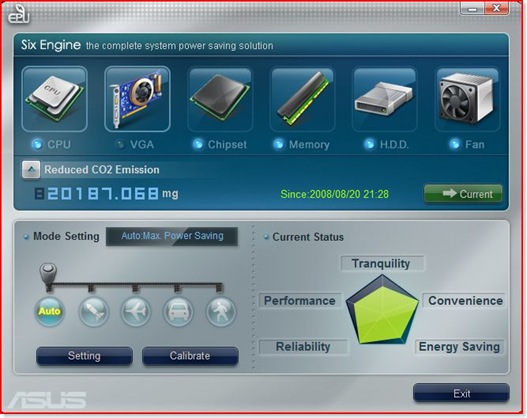Recently, computer manufacturers have started thinking about factors other than performance, the main others being heat and power consumption. This is where Asus's offering, EPU, comes in. Asus motherboards with EPU have a small chip located near the CPU which watched in real-time the load the cpu, and adjusts power supply accordingly. Motherboards that further support EPU Six Engine support similar monitoring for other components, such as the ram, graphics card(most supported cards are made by Asus), and ram. This can be controlled through the Six Engine software which is bundled with all supported motherboards.
The software allows several presets(customizable of course), and shows the amount of CO2 that has been saved by using EPU. Clicking on the cpu (or graphics card if you have a supported card) icon shows the current power draw, as well as the total energy savings on the component.
The modes offered are Auto(which just chooses between the other modes based on load), Turbo(Auto-overclocking, you can set the percent), High Performance(Stock everything), Medium Power Savings(Downclock, undervolt), Max. Power Savings(Downclock more, more undervolt).
In my experience with a Q6600, turbo mode became a bit unstable beyond 15%, and Max. Power Savings became a bit unstable below 46%(The percentages are the change from the stock 2.4ghz, the clock changes are done in the FSB, although speedstep is also used, meaning that my processor varies between 2.76Ghz and 864mhz. The power usage also varies a lot, as idle at 864mhz is about 5watts for the cpu, whereas it is 15watts idle at 2.76ghz. Load power is about 20watts at 864mhz, and 50watts at 2.76ghz.
Overall, this tool will help keep both temperature and power use under control. Idle temperatures with the lowest setting are 32c(using a 3rd party cooler), while the stock clock idles at 35/36c.


1 comment:
Can anyone recommend the top performing Remote Management & Monitoring utility for a small IT service company like mine? Does anyone use Kaseya.com or GFI.com? How do they compare to these guys I found recently: N-able N-central remote management
? What is your best take in cost vs performance among those three? I need a good advice please... Thanks in advance!
Post a Comment